
Saskatoon Northwest is a provincial electoral district for the Legislative Assembly of Saskatchewan, Canada. It covers the neighborhoods of Lawson Heights, Silverwood Heights and the surrounding area. This constituency includes Wanuskewin Heritage Park, Saskatoon Correctional Centre and the SaskTel Centre.

Langham is a town in Saskatchewan, Canada. It is located on Highway 16, 35 kilometres northwest of the city of Saskatoon. The 2011 census reported a population of 1,290, with 489 homes in the community.

The Exhibition subdivision of Saskatoon, Saskatchewan, Canada, is located on the banks of the South Saskatchewan River and was developed between the two major World Wars. To the west is the Diefenbaker Management Area which boasts the Diefenbaker park and Pioneer Cemetery. The park includes a medium-sized hill which is used for tobogganing and snowboarding, and the park itself is a frequently-used venue for picnics and public events and performances. The Exhibition community is also known as Thornton, after a (now-demolished) public elementary school that formerly served the area and early in its history also went by the name Bellevue.

Dundurn is a town of 647 residents in the rural municipality of Dundurn No. 314, in the Canadian province of Saskatchewan. Dundurn is located on Highway 11 or Louis Riel Trail in central Saskatchewan, about 42 km south of Saskatoon. As well as being an agricultural town, it is also a bedroom community for both Camp Dundurn and Saskatoon.

Rugby Chapel is a municipal historic site which is part of the University of Saskatchewan. The U of S is the largest education institution in the Canadian province of Saskatchewan. The University of Saskatchewan location next to the South Saskatchewan River was across from the city centre of Saskatoon. In 1879, the Rt. Rev. John McLean started a schooling system in Prince Albert which was renamed the University of Saskatchewan in 1883. In 1909, when the University of Saskatchewan was established in Saskatoon, Emmanuel College moved its college buildings to Saskatoon. The Institute for stained glass in Canada has documented the stained glass at Rugby Chapel.
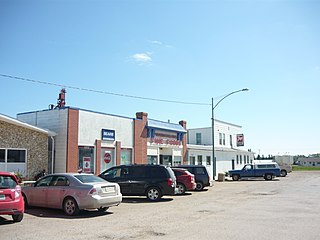
Bruno is a town located 90 km east of Saskatoon and 35 km west of Humboldt. Its current mayor is Dale Glessman.

Prairieland Park is an events centre in the south-eastern portion of Saskatoon, Saskatchewan. The park is located in the Exhibition neighborhood of Saskatoon. Each year the park hosts an annual Saskatoon Exhibition called "The Ex". During the remainder of the year most of the park venues are rented out to special events. Some events held are Western Canadian Crop Production Show, Saskatchewan indemand trade show, Saskatoon Fall Fair cattle show and sale, Pet Expo, Chuckwagon Racing, and the Prairieland Junior Ag Showcase. The park also hosts Marquis Downs.

Bladworth is a village within the Rural Municipality of McCraney No. 282, Saskatchewan, Canada. The village is located 99 kilometres (62 mi) south of the city of Saskatoon on Highway 11.
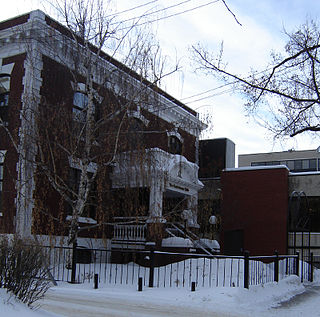
The Saskatoon Club is a business club originally established as a gentleman's club in 1907. The club is located in the Central Business District of Saskatoon, Saskatchewan. The Club operates a dining room, lounge, meeting facilities and a fitness centre. It was incorporated by a private act of the Saskatchewan Legislature.

The Land Titles Building is located at 311 21st Street East in the Central Business District of Saskatoon, Saskatchewan. The architectural firm of Storey and Van Egmond designed the building in the Romanesque Revival style. The building was constructed by Smith Brothers and Wilson in 1909. Additional expansions were done between 1910 and 1912. The building housed the land title office until 1959 when the office was transferred to the Law Courts Building. The provincial government stopped using the building when it was sold in 1994. The building now houses the law offices of Brayford and Shapiro.

The Odd Fellows Temple Building is a landmark building located in downtown Saskatoon, Saskatchewan, Canada. Built by the Independent Order of Odd Fellows the building served as a meeting place, ball room and temple until being sold in 1959 to the Saskatoon Labour Council. The building was officially designated a heritage property on April 19, 1983.
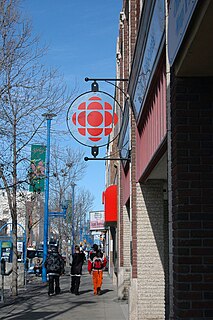
The Hutchinson Building is a landmark building located in downtown Saskatoon, Saskatchewan, Canada. The building was designed by architect Frank P. Martin built to house the Saskatoon Hardware Store Ltd until 1970 then the building was taken over by Saskatoon Handicraft Supplies until 1995. The building was designated a heritage property on August 9, 1999.
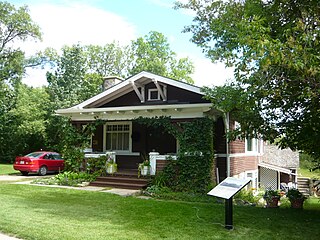
The Bowerman House is a designated Municipal Heritage Property located in the Holiday Park, neighborhood of Saskatoon, Saskatchewan, Canada. The home is of a crafts-man "Western Stick" style. The house was built as a hunting lodge by Allan Bowerman, graduate from Kingston Military College, first postmaster in Saskatoon on the west side of the river, and member of Saskatoon's first town council. Bowerman was also responsible for the development of the Canada Building. The home was designed by Walter William LaChance. Bowerman sold the home in 1917 after the end of a construction boom in the city.
The Saskatoon Electrical System Substation is a municipal designated historic building located in the Nutana neighborhood of Saskatoon, Saskatchewan, Canada. The property contains a two story building in a Modern Classical style, made of No. 2 Redcliff, Light Claybank and Tee Pee Mocha brick construction. The building was constructed in 1929 by Saskatoon Light & Power along with two other such stations to meet the growing electrical demand of the city; declared a heritage site on December 4, 2000; and renovated into offices in the 1990s the building now houses the offices of the architectural firm of Kindrachuk Agrey Architects.

The Sommerville/Petitt House is a municipally-designated, historic building located in the Nutana neighbourhood of Saskatoon, Saskatchewan, Canada. The property is a 2 1⁄2-story, stucco-and-brick house in a blended Tudor Revival and Spanish Revival style constructed in 1912. Features of the building include a tower topped with a bell-cast dome, a large arched porch with porte-cochere, and a carriage entrance supported by fieldstone pillars.
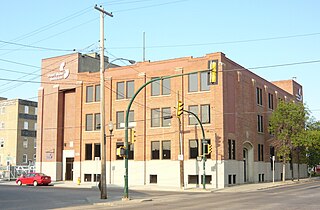
The Arthur Cook Building is a designated historic building in the Central Business District, of Saskatoon, Saskatchewan, Canada. The three-storey brick and concrete warehouse was built in 1928 by the Saskatoon Cartage and Warehouse Company. It was designed by Saskatoon architect David Webster and built by the A.W. Cassidy Co. Ltd. It was sold to MacCosham Storage and Distribution in 1945 who used it until 1978. In 1978 the building was purchased by the City of Saskatoon and became the city's central stores, as well as housing the archives.
The Landa Residence is a designated Municipal Heritage Property located in the Riversdale, neighborhood of Saskatoon, Saskatchewan, Canada. Thomas E. Heath, Saskatoon's Early Fire Chief lived in the home from 1913–1915. In 1921, the house became the family residence of William and Fanny Landa, the first Jewish family to settle in Saskatoon. William Landa was a carriage maker who immigrated from Russia established the Landa Carriage Works that eventually become the Landa Auto Body Works. The building is of a Pre-World War I Prairie Vernacular architectural style.

The F. P. Martin House is a designated Municipal Heritage Property located in the Nutana, neighborhood of Saskatoon, Saskatchewan, Canada. The house was built by local architect Frank Percy Martin, in a unique Cottage Style with double dormers, Gothic doorways, and lattice windows.

The Albert Community Centre is a designated Municipal Heritage Property located in the Varsity View, neighborhood of Saskatoon, Saskatchewan, Canada. Originally built as the Albert School, the two-and-a-half storey brick building served as a public school until 1978 when the building was sold to the city and became the Albert Community Centre. The school was originally named for Prince Albert, Queen Victoria's Consort. The most noticeable feature of the building include limestone trim, crenellated tower, crossed mullioned windows, dormers and curved parapet gables.





















